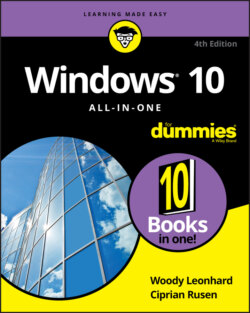Читать книгу Windows 10 All-in-One For Dummies - Ciprian Adrian Rusen, Woody Leonhard - Страница 56
Exploring new stuff in the old-fashioned desktop
ОглавлениеYou’ll notice many improvements to long-neglected portions of the Windows 7–style desktop. For example, if you copy more than one file at a time, Windows actually keeps you on top of all the copying in one window. Imagine that.
A new and much better Task Manager rolls in all the usage reporting that’s been scattered in different corners of Windows (see Figure 2-8). The new Task Manager even gives you hooks to look at programs that start automatically, and to stop them if you like. Some serious chops. See Book 8, Chapter 4.
FIGURE 2-8: The new and greatly improved Task Manager.
File Explorer (formerly known as Windows Explorer) takes on a new face and loses some of its annoying bad habits. You may or may not like the new Explorer, but at least Windows 10 brings back the up arrow to move up one folder — a feature that last appeared in Windows XP. That one feature, all by itself, makes me feel good about the new File Explorer. Explorer also now offers native support for ISO files. About time.
Taking a cue from iPad, Windows 10 also offers a one-stop system restore capability. With Reset This PC, you can remove apps and settings and keep personal files, or wipe everything and reset Windows 10 to its factory defaults and files. It's like it pulls in a brand-spanking-new version of Windows 10. See Book 8, Chapter 2 for more details.
Storage Spaces requires at least two available hard drives — not including the one you use to boot the PC. If you can afford the disk space, Windows 10 can give you a fully redundant, hot backup of everything, all the time. If a hard drive dies, you disconnect the dead one, slip in a new one, grab a cup of coffee, and you’re up and running as if nothing happened. If you run out of disk space, stick another drive in the PC or attach it with a USB cable, and Windows figures it all out. It’s a magical capability that debuted in Windows Home Server, now made more robust. See Book 7, Chapter 4 for more on Storage Spaces.
Backup gets a major boost with an Apple Time Machine work-alike called File History. You may not realize it, but Windows 7 had the capability to restore previous versions of your data files. Windows 10 offers the same functionality, but in a much nicer package — so you’re more likely to discover that it’s there. See Book 8, Chapter 1. Unfortunately, Windows 10 drops the capability to create whole-disk ghost backups — you need to buy a third-party program such as Acronis if a full backup is in your future.
Power options have changed significantly. Again. The new options allow Windows to restart itself much faster than ever before.
If you ever wanted to run a Virtual Machine inside Windows, Microsoft has made Hyper-V available, free. It’s a rather esoteric capability that can come in very handy if you need to run two different copies of an operating system on one machine. You must be running a 64-bit version of Windows 10 Pro (or Enterprise), with at least 4GB of RAM. See Book 8, Chapter 4.
